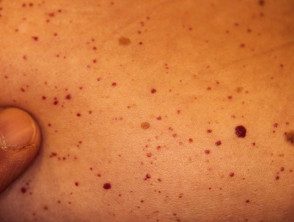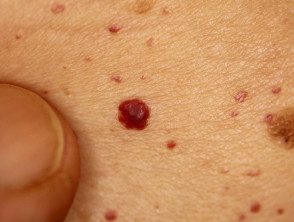What is Fabry disease?
Fabry disease is a rare inherited disease. lysosomal storage disorder [1]. It is also known as Anderson-Fabry disease and angiokeratoma corporis diffusum.
Fabry disease causes clusters of small dark red spots on the skin (angiokeratomas) And more systemic symptoms due to statement of globotriaosilceramide in multiple organs.
Angiokeratomas in suspected Fabry disease

Angiokeratomas in suspected Fabry disease

Angiokeratomas in suspected Fabry disease

Angiokeratomas in Fabry disease
Who gets Fabry disease?
The estimate predominance in men it is approximately one in 40,000 to 60,000 of the population [4]. Fabry disease generally affects men more severely and at an earlier age than women because their inheritance is X-linked (men only carry an X chromosome while females have two). Fabry disease can occur in all ethnic groups. [5].
The age of onset of Fabry disease can vary from the second to the fifth decade of life or later.
Fabry disease often presents with nonspecific symptoms that may be mild and subtle and is commonly overlooked or misdiagnosed, leading to an underestimation of its prevalence. [6].
What causes Fabry disease?
Fabry disease is caused by a mutation of alpha-galactosidase A gene (GLA) mapped to the long arm of the X chromosome [7]. There are hundreds of different pathogen variants of the mutation, resulting in different symptoms and varying severity [8]. Men with Fabry disease pass the gene on to all daughters, but not to any of their sons. Women with Fabry disease have a 50% chance of passing the gene on to their daughters or sons. Some women are affected as severely as men due to random inactivation of the X chromosome [9].
the enzyme alpha-galactosidase A catalyzes the separation (neckline) of the terminal galactose of globotriaosilceramide (Gb3). Gb3 is an intermediary in the degradative pathway of the globe (a glucosphingolipid), a major component of some cell membranes. Lack of the enzyme alpha-galactosidase A leads to the accumulation of Gb3 in various tissues, leading to cell death. The most clinically significant Gb3 accumulation sites are blood vessels skin, heart nervesand kidneys [10].
What are the clinical features of Fabry disease?
The characteristic features of Fabry disease are:
- Small bunches, dark red papules (angiokeratomas)
- Heat intolerance and reduced sweating (hypohidrosis)
- Episodes of neuropathic pain in the hands and feet (acroparesthesia), precipitate due to stress or extremes of temperature
- Cloudiness cornea
- Hearing loss [2]
- Abdominal symptoms such as pain, nausea, vomiting, and diarrhea or constipation. [3]
- Recurrent fever, fatigue, psychological and social problems
- Serious and life-threatening complications, such as kidney damage, heart disease, and stroke.
Dermatological manifestations occur in more than 70% of Fabry disease patients, with a mean age of onset of 17 years. [5].
Angiokeratomas
Angiokeratomas are dilated blood vessels in the upper part. dermis, presenting as red or black papules. Papules do not whiten with pressure, and older injuries can become warty. Clusters o diffuse Angiokeratomas appearing for the first time in young adults should alert to a possible diagnosis of Fabry disease.
In Fabry disease, angiokeratomas are caused by the accumulation of Gb3 in the dermal endothelial cells, leading to bulging and incompetence of the vessel wall [12]. Angiokeratomas are usually located in the swimsuit area (from the belly button to the upper thighs, including the genitals). More than a third of patients also develop angiokeratomas and telangiectasia on the lips and inside the mouth [13].
There is no correlation between the severity of the disease and the extent of angiokeratomas. [eleven].
Hypohidrosis
Hypohidrosis is a common feature of Fabry disease that leads to dry skin and heat intolerance. [eleven]. It is likely to be the result of abnormal autonomic nervous response due to Gb3 deposition.
Other cutaneous manifestations of Fabry disease
Fabry disease is identified by other skin signs, such as:
-
Lymphedema of the lower legs. [eleven]
- Sparse and fine facial hair [11]
- Raynaud's phenomenon [14].
What are the complications of Fabry disease?
The three most serious complications of Fabry disease are kidney disease, heart disease, and cerebrovascular disease [5].
- Kidney disease ranges from isolated proteinuria to end stage renal failure [5].
- Heart disease includes left ventricle hypertrophy, heart failure, coronary heart disease and arrhythmias.
- Cerebrovascular disease includes transient ischemic ischemic attacks and strokes.
How is Fabry disease diagnosed?
Male and female patients are diagnosed differently.
- Male patients can be diagnosed by a blood test. A very low level of alpha-galactosidase A activity (<3%) es suficiente para diagnosticar la enfermedad de Fabry, mientras que un nivel superior al 35% excluye la enfermedad de Fabry. Los niveles de actividad entre estas cifras requieren genetic analysis to confirm the diagnosis.
- Female patients have variable enzyme activities with a significant proportion showing normal activity, therefore, the diagnosis of Fabry disease must be made by genetic analysis.
- If the genetic analysis does not identify a mutation that causes the disease specific to Fabry disease, a biopsy of affected organs (including skin biopsy) can be considered; this can show intracellular Gb3 accumulation [5,11].
Family members of the diagnosed patient should also be tested for Fabry disease.
Urine and ECG tests should be done to detect heart and kidney abnormalities.
Which is the differential diagnosis for Fabry disease?
Due to its rarity and wide range of non-specific clinical characteristics, Fabry disease is often misdiagnosed. He can be considered a "great impostor" [15].
Angiokeratomas are not characteristic of Fabry disease since solitary lesions can occur in healthy individuals. They are also found in patients with hereditary hemorrhagic telangiectasia and the other lysosomal disorders; Schindler's disease, fucosidosis, aspartylglucosaminuria, beta-mannosidosis, and sialidosis [11,12].
The most common misdiagnoses are as follows:
- Rheumatological conditions such as rheumatic fever or dermatomyositis: the dermatological manifestations are different in appearance and time course
- Neuropsychological disease and fibromyalgia, in which there is an absence of heart, kidney, nerve and skin involvement.
- Polycythemia vera and essential thrombocythemia: Fabry disease does not cause an increase platelet tell
-
Hereditary hemorrhagic telangiectasia: Fabry disease does not usually cause spontaneous epistaxis or gastrointestinal bleeding
- Irritable colon syndrome - this has no other systemic manifestations [6,16].
What is the treatment for Fabry disease?
Once diagnosed, male patients with Fabry disease are often prescribed enzyme replacement therapy, regardless of clinical characteristics. [2,11,18]. Female patients should only be treated if they have significant clinical manifestations.
Enzyme replacement therapy provides patients with alpha-galactosidase A deficient enzyme. It reduces the severity and progression of disease manifestations, especially neuropathic pain and kidney disease, by reducing Gb3 deposition in tissues. Its effect on cardiovascular manifestations is less clear. [18].
Fabry disease patients may require input from multiple specialties, including GPs, cardiologists, nephrologists, neurologists, and dermatologists, to control their individual organ manifestations. Neuropathic pain in the hand and feet may respond to anticonvulsants, such as carbamazepine. [18,19].
Treatment for angiokeratomas includes cryotherapy, electrocoagulation, excision surgery and To be therapy [11,12,20].
What is the result of Fabry disease?
Fabry's disease is progressive and it can be deadly. the forecast it varies from patient to patient [21]. Survival is significantly reduced in male patients with severe forms of Fabry disease under the age of 60, often 40 or 50 years. Most deaths are due to cardiovascular diseases, such as stroke, myocardium heart attackand heart failure. Death from kidney failure, septicemia, and suicides have also been reported [18]. The benefit of enzyme replacement therapy on the overall prognosis is unclear due to a lack of current evidence [18,22,23].
